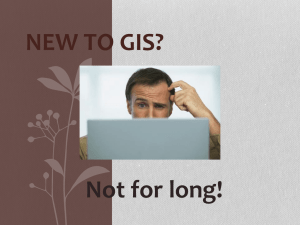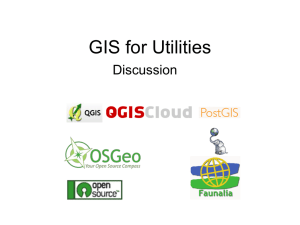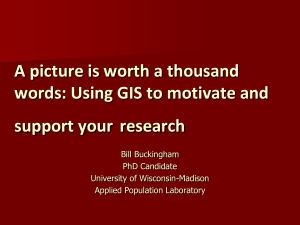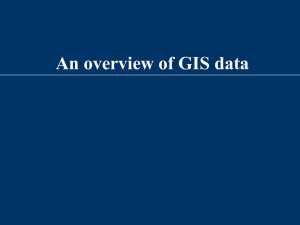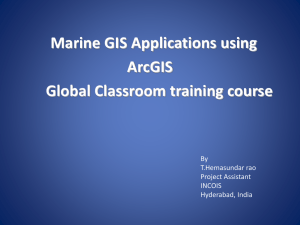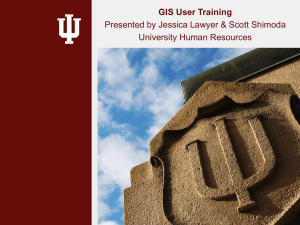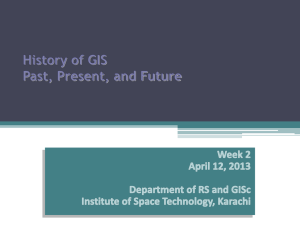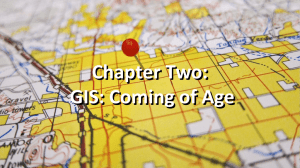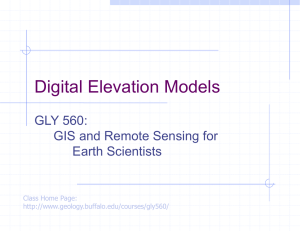Chapter 3: Components of GIS - Singapore GeoSpatial Challenge
advertisement
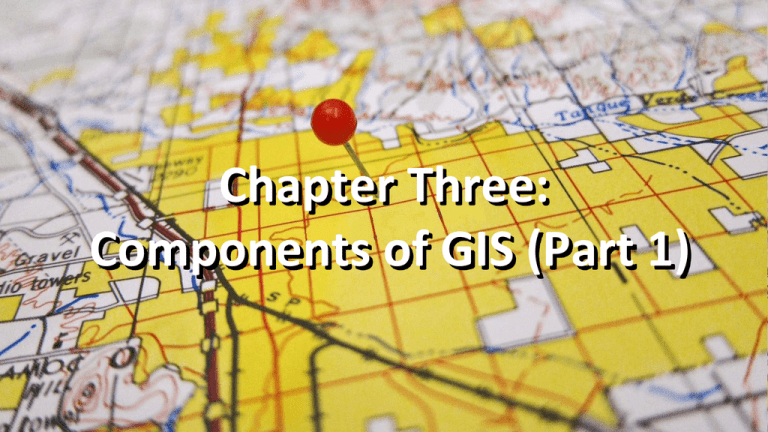
Chapter Three: Components of GIS (Part 1) A successful GIS has 5 critical components: Source: 1. http://bgis.sanbi.org/gis-primer/page_12.htm a) Hardware b) Software c) Data d) People e) Methods (a) Hardware: Hardware is the computer system on which a GIS operates. Today, GIS runs on a wide range of hardware types, from centralized computer servers to laptops and smart phones used in standalone or networked configurations. (b) Software: GIS software provides the functions and tools needed to store, analyze, and display geographic information. Source: 1. http://www.iceburghsolutions.com/services/services.htm 2. http://bgis.sanbi.org/gis-primer/page_12.htm (c) Points Polygons Data: Perhaps the most important component of a GIS. Geographic data and its attributes can be collected inhouse, sourced or purchased from data providers. All geographic features on the earth can be characterized and represented as one of three basic feature types points, lines, and polygons: Points Lines Lines Polygons Source: 1. http://www.gisdevelopment.net/technology/gis/techgi0047a.htm 2. http://bgis.sanbi.org/gis-primer/page_12.htm 3. http://en.wikipedia.org/wiki/GIS_file_formats i. Points are used to represent single location feature like a tree, a fire pump, a lamp post, a bus stop, a taxi stand, a monument…etc. A point can also be displayed as a symbol. ii. Lines are used to represent linear features like rivers, roads, canals, drainages, water pipes, gas pipes, networks…etc. iii. Polygons are used to represent enclosures or areas like lakes, boundaries, building footprints, flooded areas, contaminated areas, reservoirs, forested areas, nature reserves…etc. Source: 1. http://newsletter.flatworldknowledge.com/ 2. http://lemonprogis.com/what-are-gis-data-types/ Please do note that under different map scale, feature type of certain features may change to represent the real world better. Aljunied MRT station is displayed as a polygon in scale 1:1000 Aljunied MRT station is displayed as a point (represented by a MRT symbol) in scale 1:20,000 Source: 1. http://www.onemap.sg/ Choose the most appropriate feature type (point, line or polygon?) for features listed below under the designated scale : Scale 1:1000 (tourist map) Scale 1:50,000 (topographic map) Feature Hawker Centre Heritage Tree Pedestrian Bridge Flash Flood Man Hole Park Connector Roundabout Cemetery Recycle Bins Bus Service Route Point Line Polygon Choose the most appropriate feature type (point, line or polygon?) for features listed below under the designated scale : Scale 1:1000 (tourist map) Scale 1:50,000 (topographic map) Feature Point Line √ Hawker Centre Heritage Tree Polygon √ Pedestrian Bridge √ Flash Flood √ Man Hole √ √ Park Connector Roundabout √ Cemetery √ Recycle Bins Bus Service Route √ √ Did you get all the answers correct…? No worries! As you explore more about GIS in this e-Learning section, you definitely understand more. Let’s move on to the next chapter to continue our learning journey… Chapter Three: Components of GIS (Part 2) Let’s continue with the third component of GIS Data: Each feature type can be displayed in both two types of data formats/structures Vector & Raster: Source: 1. http://bgis.sanbi.org/gis-primer/page_07.htm 2. http://bgis.sanbi.org/gis-primer/page_15.htm 3. http://www.geo.hunter.cuny.edu/~rdatta/gis2/lectures/Lecture2/lecture2.htm 4. http://usgin.org/content/rasters-and-vectors-comparison 5. http://wiki.gis.com/wiki/index.php/Discrete_and_Continuous_Data 1) In vector format: Each feature is composed by a vertex or vertices. Each vertex consists of a pair of X and Y coordinate. Point features are defined by one coordinate pair – a vertex. Line features are defined by a string of vertices – also known as an “arc”. Polygonal features are defined by a set of closed coordinate pairs. Vectors are best suited to represent features that have distinct boundaries or limits that are discrete in space and time, e.g. buildings, parks or roads. Discrete data is helpful in showing exact location, perimeter, and length of objects. 2) In raster format : A raster consists of a matrix of cells (or pixels) organized into rows and columns (or a grid). Each cell contains a value representing information of the feature being represented. Rasters represent points by a single cell, lines by sequences of neighbouring cells and polygons/areas by collections of contiguous cells. Rasters are best suited to representing continuous data geographic phenomena that do not have well-defined boundaries and are found everywhere throughout the mapped area. Continuous data are often shown in a colour scale in order to show change over an extent, e.g. temperature across a region. Source: 1. http://www.geo.hunter.cuny.edu/~rdatta/gis2/lectures/Lecture2/lecture2.htm 2. http://webhelp.esri.com/arcgisdesktop/9.2/index.cfm?TopicName=What_is_raster_data%3F 3. http://www.satimagingcorp.com/gallery/ikonos-singapore-lg.html 4. http://usgin.org/content/rasters-and-vectors-comparison 5. http://wiki.gis.com/wiki/index.php/Discrete_and_Continuous_Data Cells / Pixels Choose the most appropriate data format (vector or raster?) for each of the situation encountered below: No. Situation 1 I want to map out the sea temperature of South China Sea during the Monsoon season between 2000 and 2010. 2 I want to display the location of all children playgrounds within HDB estates in Ang Mo Kio. 3 I want to produce a map that shows the average daily rainfall volume in Bukit Batok area for the first-half of the year. 4 I need a map that displays the exact compound of my school. 5 I have to represent the overall air quality of Singapore for the past five years on a map. 6 I need to produce a map that showcases the hilly area of Sumatra. 7 I need to map out all major roads, rivers and canals in Singapore. Vector Raster Choose the most appropriate data format (vector or raster?) for each of the situation encountered below: No. Situation 1 I want to map out the sea temperature of South China Sea during the Monsoon season between 2000 and 2010. 2 I want to display the location of all children playgrounds within HDB estates in Ang Mo Kio. 3 I want to produce a map that shows the average daily rainfall volume in Bukit Batok area for the first-half of the year. 4 I need a map that displays the exact compound of my school. 5 I have to represent the overall air quality of Singapore for the past five years on a map. 6 I need to produce a map that showcases the hilly area of Sumatra. 7 Vector Temperature is continuous – no fixed perimeters √ Rainfall is continuous – its volume gradually increases or decreases √ Air quality is continuous – air particles have no fixed location Earth surface or terrain is continuous – it either elevates or descends gradually I need to map out all major roads, rivers and canals in Singapore. √ Raster √ Playground is discrete in nature with exact perimeter & distinct location √ Building compound is discrete in nature – exact perimeter is possible √ √ Roads and water bodies are discrete – exact perimeter is possible (d) People: GIS is pointless without the people who manage, analyse and map out geospatial data to resolve real world problems. People who are specialized in GIS can be designated as GIS specialist, geospatial consultant, GIS manager and others, though not really common in Singapore. Source: 1. http://www.cadalyst.com 2. http://flowergarden.noaa.gov 3. http://www.gaaged.org (e) Methods: A successful GIS operates according to a well-designed implementation plan and procedures, which are the models and operating practices unique to each organization. Source: 1. http://bgis.sanbi.org/gis-primer/page_12.htm 2. http://www.esri.com 3. http://www.latitudecartography.co.uk/

